wg48temp9
National Hazard
   
Posts: 784
Registered: 30-12-2018
Location: not so United Kingdom
Member Is Offline
|
|
Just arrived API 365 Triple Quadrupole Mass Spectrometer
My Triple Quadrupole Mass Spectrometer just arrived on a pallet with a big metal box. The turbo pumps are there with lots of other vacuum goodies.
I just need to move it now or attempt to.
Just checking it over now. It has a bank of 20 small electrically operated gas valves, several pneumatic valves, lots of KF25 flanges, lots of small
piping with couplings, at least three vacuum sensors. The bank of boards and modules may still be there hopefully with the drive electronics for the
turbo pumps and possible the drive for the quadrupoles.
Its almost criminal to strip it down.
[Edited on 11/19/2020 by wg48temp9]
I am wg48 but not on my usual pc hence the temp handle.
Thank goodness for Fleming and the fungi.
Old codger' lives matters, wear a mask and help save them.
Be aware of demagoguery, keep your frontal lobes fully engaged.
I don't know who invented mRNA vaccines but they should get a fancy medal and I hope they made a shed load of money from it.
|
|
|
Metacelsus
International Hazard
    
Posts: 2539
Registered: 26-12-2012
Location: Boston, MA
Member Is Offline
Mood: Double, double, toil and trouble
|
|
Very cool! I hope you can post pictures.
|
|
|
Heptylene
Hazard to Others
  
Posts: 319
Registered: 22-10-2016
Member Is Offline
Mood: No Mood
|
|
+1 for pictures, vacuum equipment is always delightful to see!
You orignially bought it for its parts?
|
|
|
wg48temp9
National Hazard
   
Posts: 784
Registered: 30-12-2018
Location: not so United Kingdom
Member Is Offline
|
|
All but one of the boards are missing. In particular the vacuum gauge board and the RF board is missing. The high vacuum sensor is there but its just
the glass ionisation gauge head. There are two diaphragm type vacuum sensors.
The turbo pump drives are there but big one had a label saying faulty and the vanes of the pump look distorted but its difficult to see. The small
pump looks ok and its driver looks simple to interface 240VAC in and three control signals with various status output signals. Surprisingly no
large bore vacuum valves.
I was hoping for at least one self contained high vacuum gauge and one large bore valve.
The MS part is a tube about more than a meter long that apparently contains two quadrupoles and in between them a gadget to break up large ions. The
two turbo pumps bolt direction to openings on the tube
Yes I have purchased it for the parts but if I could have got the MS part working that would have been fun. Yes I will take pictures.
The big turbo pump is damaged and will not turn. The smaller one does turn freely. Its driven by a three phase induction motor induction at up to
about 1kHz. So if the drive electronics module is faulty and I can not fix it it should be relatively easily replaced.
The seller of the MS was also selling rotary vane pumps and turbo pumps presumable from MSs, so I figured the turbo pumps probably would not work.
I was hoping I could fix one of them particularly if its the electronics that's faulty.
[Edited on 11/20/2020 by wg48temp9]
I am wg48 but not on my usual pc hence the temp handle.
Thank goodness for Fleming and the fungi.
Old codger' lives matters, wear a mask and help save them.
Be aware of demagoguery, keep your frontal lobes fully engaged.
I don't know who invented mRNA vaccines but they should get a fancy medal and I hope they made a shed load of money from it.
|
|
|
wg48temp9
National Hazard
   
Posts: 784
Registered: 30-12-2018
Location: not so United Kingdom
Member Is Offline
|
|
I am delighted, the small turbo pump and controller works at ambient pressure at low speed. I got super lucky.
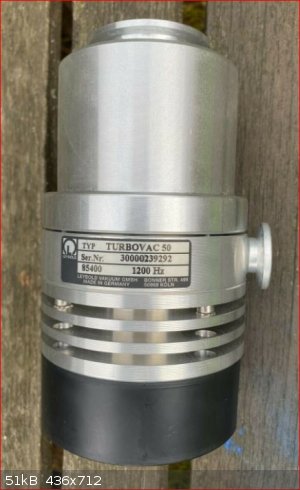
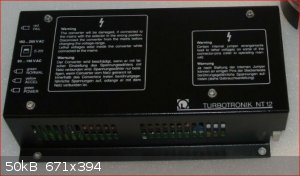
It has a compression ratio for Nitrogen of about 2 x 10^6
and can reach a vacuum of better than 10^-10 bar. That is a mean free path length of more than a kilometer in air and 5.6 times that for an electron
in air.
file]84664[/file]
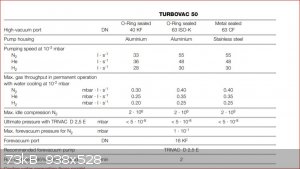
I am wg48 but not on my usual pc hence the temp handle.
Thank goodness for Fleming and the fungi.
Old codger' lives matters, wear a mask and help save them.
Be aware of demagoguery, keep your frontal lobes fully engaged.
I don't know who invented mRNA vaccines but they should get a fancy medal and I hope they made a shed load of money from it.
|
|
|
wg48temp9
National Hazard
   
Posts: 784
Registered: 30-12-2018
Location: not so United Kingdom
Member Is Offline
|
|
I dismantled the damaged large turbopump (turbovac 361). It contained 12 rotor discs and 11 stator disks. All the stator discs are damaged. Most have
all of the vanes sripped off. Many of the rotor discs vanes are distorted and several are broken off. After five hours of careful dissection I had
removed the remains of the stator discs and hundreds of broken off and distorted stator vanes .
The rotor now rotates freely but makes a sound similar to a worn front wheel bearing of a car. I will see if it can still rotate, powered by the
controller module, only at low speed as it is now not balance. I want to know if the controller still functions. Its an up to 800Hz three phase power
oscillator of several hundred Watts. I will take some pics when I find my memory card for my camera.
Below is a pic of an intact turbovac 361.
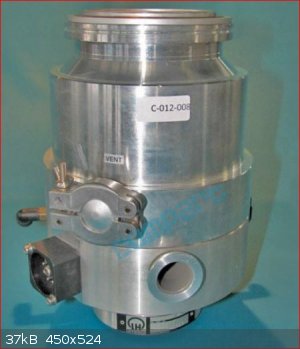
I am wg48 but not on my usual pc hence the temp handle.
Thank goodness for Fleming and the fungi.
Old codger' lives matters, wear a mask and help save them.
Be aware of demagoguery, keep your frontal lobes fully engaged.
I don't know who invented mRNA vaccines but they should get a fancy medal and I hope they made a shed load of money from it.
|
|
|
wg48temp9
National Hazard
   
Posts: 784
Registered: 30-12-2018
Location: not so United Kingdom
Member Is Offline
|
|
Here are some pics of the deconstruction of the damaged large turbo pump and other parts from the triple MS.
The damaged rotor
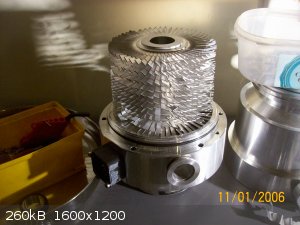
The stripped vanes of the sator discs
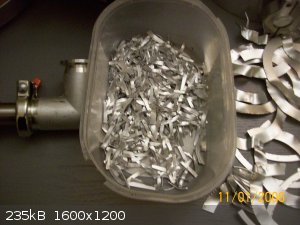
The remains of the stator discs
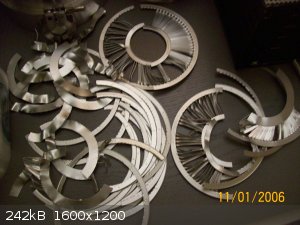
The central item is the top housing of the pump with the screen and o-ring flange fitted. The set of rings on the right are the spacers that
are placed between the stator discs
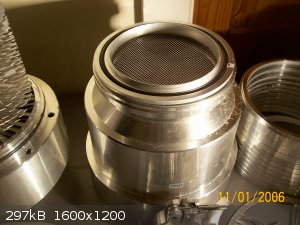
The turbo pump controller

Some vacuum parts: left; ionization gauge, center; venturi pump used reduce pressure in the electrospray unit, bottom; SS fittings and the square item
(under the date which I forgot to update) is a vacuum pressure switch
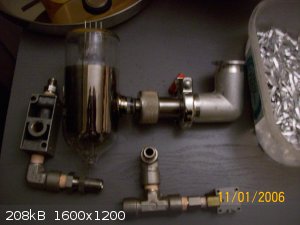
I am wg48 but not on my usual pc hence the temp handle.
Thank goodness for Fleming and the fungi.
Old codger' lives matters, wear a mask and help save them.
Be aware of demagoguery, keep your frontal lobes fully engaged.
I don't know who invented mRNA vaccines but they should get a fancy medal and I hope they made a shed load of money from it.
|
|
|
wg48temp9
National Hazard
   
Posts: 784
Registered: 30-12-2018
Location: not so United Kingdom
Member Is Offline
|
|
More pics of parts of the MS
The ion detector module: the plate at the mouth of the horn electron multiplier is struck by ions which then eject electrons that are attracted to
the mouth of the horn. The electrons again collide with the horn and create even more electrons which in turn collide and create more. Apparently
such horns can multiply a single electron to thousands of electrons.
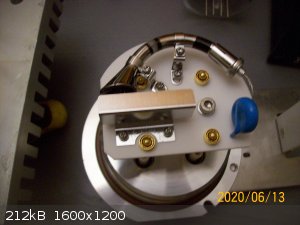
Side view of the ion detector module.
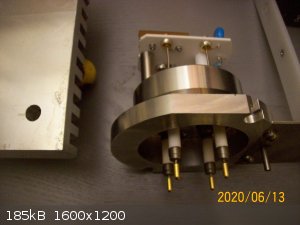
One of the tuned coils that drive the RF signals to the quadrupoles. It
looks like cotton covered wire probably for low loss reasons
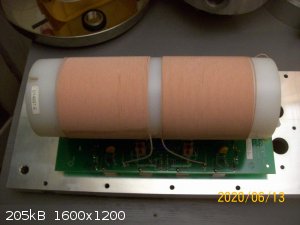
A couple of electrical feedthroughs that connected the tuned coil to the quadrupole through the wall of its vacuum tube.
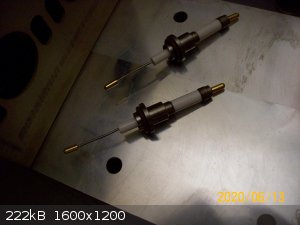
PS: I was wondering what the purpose of the tuned coils was apart from filtering out any harmonics from the input drive. It is two series connected
tuned circuits. One end of each coil is loaded with the capacitance of the quadrupole rods and a small tuning capacitor. The other end of each coil
(center of the coil former) is connected to a RF generator. So assume its used to step up the voltage from a generator using transistors to the about
500VAC required for the quadrupole. It also provides a convenient method for adding a DC voltage.
[Edited on 12/7/2020 by wg48temp9]
[Edited on 12/7/2020 by wg48temp9]
I am wg48 but not on my usual pc hence the temp handle.
Thank goodness for Fleming and the fungi.
Old codger' lives matters, wear a mask and help save them.
Be aware of demagoguery, keep your frontal lobes fully engaged.
I don't know who invented mRNA vaccines but they should get a fancy medal and I hope they made a shed load of money from it.
|
|
|
wg48temp9
National Hazard
   
Posts: 784
Registered: 30-12-2018
Location: not so United Kingdom
Member Is Offline
|
|
Here is the eye candy for those into to this sort of thing: pics of the quadrupoles. The whole assemble slides out of the stainless steel vacuum tube
or it does when all its connections are disconnected and the internal flange is loosened.
This is the front end (the input) of the first quadrupole. The skimmer was in front of this (not shown in this post). The large discs with the brown
o-ring is an internal vacuum flange that seals to the internal surface of the vacuum tube when those two disc are clamped together.
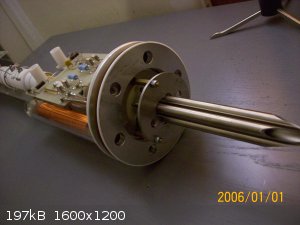
This is the rear end of the first quadrupole. The quadrupole is the four gold coloured rods which are a continuation of the four stainless steel rods
in the previous pic. I don't know the purpose of the board and inductors.
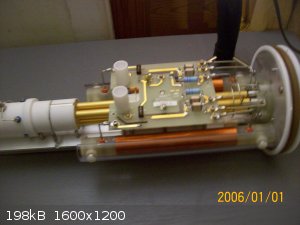
This is the second quadrupole. Possibly used to break up large ions by collisions with a gas but it does to appear to have a gas supply and its open
to the high vacuum.
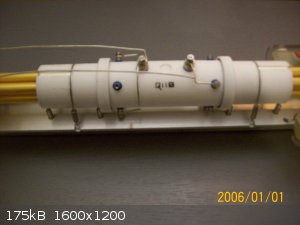
This is the third and last quadrupole. Its output (on the left) is directed to the detector module shown in the previous post.
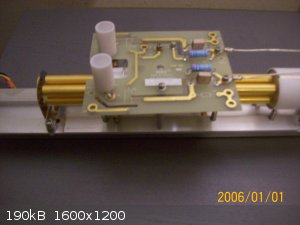
Below are some closeup pics
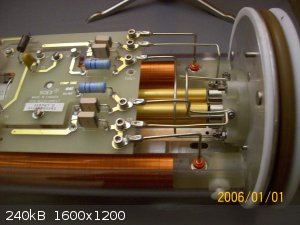
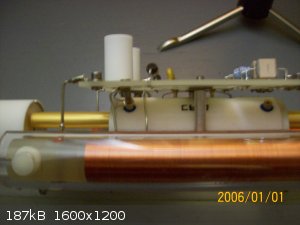
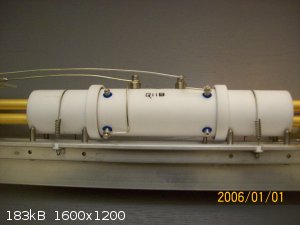
PS: On closer inspection of the connections the second quadrupole is driven by the RF from the third quadrupole via capacitors so it does not have a
DC voltages on the rods. It does have connection via the sprung clamps at each end which I suspect are focussing voltages for electrodes at each end
of the rods.
The stainless steel rods appear to be connected to the gold colored rods immediately after them via DC blocking capacitors. There are additional
connection to them via the long inductors and one direct connection.
The vacuum flange isolates the high vacuum from the lower vacuum of the front end of the stainless steel rods, presumably except for one small hole
between the stainless steel rods and the gold colored rods.
I suspect only one quadrupole and the detector module would be needed to form a MS. That would still leave how to get what ever is going to be
analysed converted to ions and injected in to the quadrupole. The original skimmer requires three voltages a supply of inert gas and three different
vacuums so I will not be attempting to use that.
Apparently the original MS could be used to analyse molecules as big as proteins which was a big surprise to me.
[Edited on 12/8/2020 by wg48temp9]
I am wg48 but not on my usual pc hence the temp handle.
Thank goodness for Fleming and the fungi.
Old codger' lives matters, wear a mask and help save them.
Be aware of demagoguery, keep your frontal lobes fully engaged.
I don't know who invented mRNA vaccines but they should get a fancy medal and I hope they made a shed load of money from it.
|
|
|
wg48temp9
National Hazard
   
Posts: 784
Registered: 30-12-2018
Location: not so United Kingdom
Member Is Offline
|
|
Here are some pics of the skimmer which was fitted in front of the stainless steel rods of the first quadrupole.
The front of the skimmer and may be part of the electrospray unit, the first entrance hole can be seen in the center. An additional unit, possibly
the main electrospray unit, which I do not have, could be attached to the front of the skimmer.
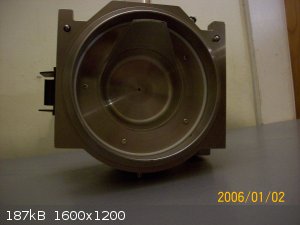
Bottom view of the skimmer. A quick disconnect for the curtain gas supply can be seen next to three high voltage connectors for acceleration and
focusing voltages. The KF25 vacuum flange is the first vacuum connection and most contaminated.
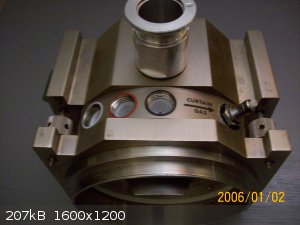
A closeup pic of the first skimmer cone. Though it can not be seen in the pic there is a small hole at the apex of the small cone.
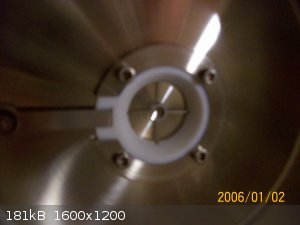
A pic of the second skimmer cone and mounting plate and ring. It also has a small hole at its apex.
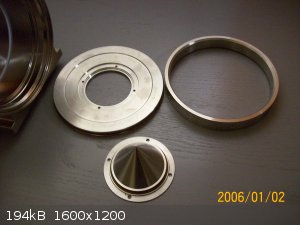
Another view of the mounting ring of the second skimmer cone
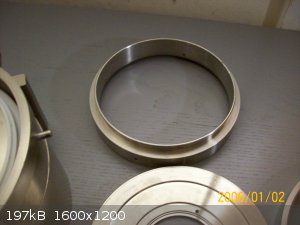
PS: That about completes my images of all the major components of the API 365. Dismantling it was the most fun I have had for £10.50 (exclunding
delivery).
[Edited on 12/9/2020 by wg48temp9]
I am wg48 but not on my usual pc hence the temp handle.
Thank goodness for Fleming and the fungi.
Old codger' lives matters, wear a mask and help save them.
Be aware of demagoguery, keep your frontal lobes fully engaged.
I don't know who invented mRNA vaccines but they should get a fancy medal and I hope they made a shed load of money from it.
|
|
|
Metacelsus
International Hazard
    
Posts: 2539
Registered: 26-12-2012
Location: Boston, MA
Member Is Offline
Mood: Double, double, toil and trouble
|
|
Very cool! Thanks for sharing the photos. I can't believe it was only £10.50 (although I suspect the shipping was considerably more).
|
|
|
wg48temp9
National Hazard
   
Posts: 784
Registered: 30-12-2018
Location: not so United Kingdom
Member Is Offline
|
|
Quote: Originally posted by Metacelsus  | | Very cool! Thanks for sharing the photos. I can't believe it was only £10.50 (although I suspect the shipping was considerably more).
|
Yes just just £10.50 but £120 delivery. But I thought the delivery was very reasonable considering its size and weight and it came with its
mounting box that would have contained two rotary vane pumps.
I think I did post a pic of the complete unit in an other thread but to give some context to the pics of this thread below is an other one.
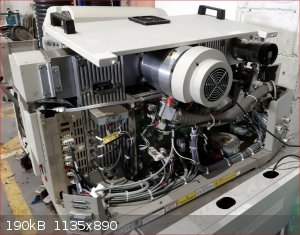
The stainless steel vacuum tube, housing the three quadrupoles, can be seen at the top running the full length of the unit with the two turbo pumps
bolted to the side of the tube. the skimmer is at the right hand end and the detector module with it cover is at the left end.
The two heatsink looking items (finned aluminum items) can be seen in particular the one on the left. They hold up the vacuum tube and on the side
that can not be seen are the tuned coils that drive quadrupoles via vacuum feedthroughs on the under side of the vacuum tube above the coils.
[Edited on 12/10/2020 by wg48temp9]
I am wg48 but not on my usual pc hence the temp handle.
Thank goodness for Fleming and the fungi.
Old codger' lives matters, wear a mask and help save them.
Be aware of demagoguery, keep your frontal lobes fully engaged.
I don't know who invented mRNA vaccines but they should get a fancy medal and I hope they made a shed load of money from it.
|
|
|
phlogiston
International Hazard
    
Posts: 1379
Registered: 26-4-2008
Location: Neon Thorium Erbium Lanthanum Neodymium Sulphur
Member Is Offline
Mood: pyrophoric
|
|
Very interesting, thanks for sharing! I've been working with triple quads for years, but it's very rare that you actually got to see most of these
parts as a user. Only sometimes when they were being serviced, but the quadruples or the collision cell hardly ever need servicing.
Another purpose for the inductors, besides filtering, might be impedance matching.
You describe some of the quadrupole rods as being stainless steel, but I've heard they are often made of more exotic materials like molybdenum. I also
suspect the plate in the detector might be made of something unusual. You'd expect them to use something that is easily ionised. That is why, for
instance, cesium is often used in photomultiplier tubes. In this case it must be something that is stable when exposed to the atmosphere, so no
alkaline meta, but its probably not simply steel either.
-----
"If a rocket goes up, who cares where it comes down, that's not my concern said Wernher von Braun" - Tom Lehrer |
|
|
Dr.Bob
International Hazard
    
Posts: 2734
Registered: 26-1-2011
Location: USA - NC
Member Is Offline
Mood: No Mood
|
|
Cool photos. I think I may have used one of those many years back. I have a seen a few views of the inner workings, but not this many and this
good, so thanks. You may be able to sell some of the pieces for more than the entire thing sold for, as well as salvage some good scrap metal and
neat things. In even older MS's like BAF instruments, some of the seals were gold plated or gold foil covered, but not as likely in that one, but
maybe other valuable bits. Nice to see something well made, not like most electronics now mass produced.
|
|
|
wg48temp9
National Hazard
   
Posts: 784
Registered: 30-12-2018
Location: not so United Kingdom
Member Is Offline
|
|
phlogiston@
I am curious about what you use your triple quad for. Can you explain an example please. I also have some questions you may be able to help me with.
I am interested in the possibility of getting one of the quads working. Initially as a residual gas analyzer. My understanding is the first quad is
used to analyse the input ions which are then broken up in the collision cell which are then analysed by the final quad. That suggests to me that I
should use the last quad as a residual gas analyzer as it may be more suitable for low mass ions.. The first and third quads have gold coloured
rods that look identical in diameter and spacing. The stainless steel looking rods, the gold coloured rods and the collision cell all have the same
length. I suspect the stainless rods are focusing mechanism. So perhaps I could use either set of gold coloured rods in a gas analyzer?
How quickly is the mass range scanned. I assume it could be slow for example a minute?
I was assuming the silver rods are stainless steel. Both the gold coloured rods and silver rods are non magnetic to even a strong magnet. The gold
colored rods are curious as they sparkle or glint so they have a crystalline surface or are contaminated with crystalline powder that does not rub
off. The crystallites are small <1mm. I hope the rods ARE made of something exotic.
I am curious about what is in the collision cell so I will dismantle it and post pics of it. Each end of the collision cell is closed of except for
small hole in the center so I can not see what is inside.
I am wg48 but not on my usual pc hence the temp handle.
Thank goodness for Fleming and the fungi.
Old codger' lives matters, wear a mask and help save them.
Be aware of demagoguery, keep your frontal lobes fully engaged.
I don't know who invented mRNA vaccines but they should get a fancy medal and I hope they made a shed load of money from it.
|
|
|
wg48temp9
National Hazard
   
Posts: 784
Registered: 30-12-2018
Location: not so United Kingdom
Member Is Offline
|
|
Quote: Originally posted by Dr.Bob  | | Cool photos. I think I may have used one of those many years back. I have a seen a few views of the inner workings, but not this many and this
good, so thanks. You may be able to sell some of the pieces for more than the entire thing sold for, as well as salvage some good scrap metal and
neat things. In even older MS's like BAF instruments, some of the seals were gold plated or gold foil covered, but not as likely in that one, but
maybe other valuable bits. Nice to see something well made, not like most electronics now mass produced. |
Yes its very well made. Reminiscent of military electronic equipment. In general I don't sell my toys but I want a calibrated vacuum gauge and
biggish gate valve so I may try selling some parts to fund those expensive items. The cheapest adapter to fit the working turbo pump to KF25 flange
was about £150 Ouch. The vacuum tube is about 200mm diameter and more than a meter long must be about 20kg. Out of curiosity I just checked the
scrap price of 316 SS £1/kilo. In any case I want I cut it in about half so I have something to bolt the small turbo pump to and mount one of the
quadrupoles.
I noticed ebay has various quadrupole assembles for sale from £100 to £800 but I guess the demand is very low.
I am wg48 but not on my usual pc hence the temp handle.
Thank goodness for Fleming and the fungi.
Old codger' lives matters, wear a mask and help save them.
Be aware of demagoguery, keep your frontal lobes fully engaged.
I don't know who invented mRNA vaccines but they should get a fancy medal and I hope they made a shed load of money from it.
|
|
|
phlogiston
International Hazard
    
Posts: 1379
Registered: 26-4-2008
Location: Neon Thorium Erbium Lanthanum Neodymium Sulphur
Member Is Offline
Mood: pyrophoric
|
|
Quote: Originally posted by wg48temp9  | phlogiston@
I am curious about what you use your triple quad for. Can you explain an example please. I also have some questions you may be able to help me with.
|
Sure, feel free to ask any questions. Its a very cool project, and it is extremely impressive if you can get it to work. This seems like a really fun
combination of electronics, machining and chemistry that I'd greatly enjoy too but don't have the time nor resources for myself, but I'd love to watch
you working on this, so if you could post some updates in the future, I'll appreciate that.
I use these kinds of instruments mostly for studying metabolic disorders. Usually, I am trying to measure specific metabolites in biological samples
such as blood, urine, organ samples or cell culture medium for diagnosing patients or for fundamental research into (human) metabolism. The target
molecules are typically things like amino acids, fatty acids, keto acids and all kinds of intermediary metabolites. These instruments are particularly
suitable for my purposes, because they are extremely sensitive (I sometimes need to quantify nM concentrations), and offer very good specificity (so I
can measure specific metabolites even in a very complex biological sample, without any complicated sample preparation). Really cool machines.
| Quote: | I am interested in the possibility of getting one of the quads working. Initially as a residual gas analyzer. My understanding is the first quad is
used to analyse the input ions which are then broken up in the collision cell which are then analysed by the final quad. That suggests to me that I
should use the last quad as a residual gas analyzer as it may be more suitable for low mass ions.. The first and third quads have gold coloured
rods that look identical in diameter and spacing. The stainless steel looking rods, the gold coloured rods and the collision cell all have the same
length. I suspect the stainless rods are focusing mechanism. So perhaps I could use either set of gold coloured rods in a gas analyzer?
|
Your description of how the 3 quads are used is indeed the most common mode that these systems are operated in (and which is often called 'multiple
reaction monitoring', or MRM)
But other modes of operation exist, and in some of those the 3rd quad is scanned across the same range as the 1st quad. I expect that the 1st and 3rd
quad are equally suitable over the entire mass range, which seems in line with your description. An example is 'SIM' mode, in which the 3rd quad is
set to or scanned synchronously across the same range as the 1st quad, and the collision cell is turned off. (this gives better sensitivity, at the
cost of reduced specificity)
| Quote: |
How quickly is the mass range scanned. I assume it could be slow for example a minute? |
There is no fundamental reason why you could not scan as slowly as you'd like. In practice, it depends on the application. In my applications, scan
times are typically 100-300 ms for full scans, or just a few ms for each mass if I am monitoring specific masses/target compounds.
The reason is that I never have an infinite supply of sample, so there are typically only a few seconds available to measure the compounds I am
interested in.
Often, these instruments are coupled to a liquid chromatography system. You need to acquire several datapoints (a minimum of 10, as a rule of thumb)
as target compounds elute from the column, to record the profile of each peak. To give some numbers: if a compound elutes of an UHPLC column in 6
seconds, and you are monitoring 10 MRM transitions, and you want at least 10 datapoints across the peak, that leaves only about 6000/10/10 = 60
milliseconds of 'dwell' time for each mass. Minus the couple of ms needed to switch between MRM transitions.
By the same criterium (10 samples for each peak), for full scans, 600 ms are available for each scan. I'd prefer a little faster, say 100-300 ms per
scan (and integrate/average in software afterwards if necessary).
For your purpose, however: you have an indefinite amount of sample, so you could just scan as slowly as you like and integrate the signal at each mass
over a long period of time, improving sensitivity.
| Quote: | I was assuming the silver rods are stainless steel. Both the gold coloured rods and silver rods are non magnetic to even a strong magnet. The gold
colored rods are curious as they sparkle or glint so they have a crystalline surface or are contaminated with crystalline powder that does not rub
off. The crystallites are small <1mm. I hope the rods ARE made of something exotic.
|
Interesting. I think the gold, crystalline surface is not contamination, but a coating of some kind,. Any contamination that I have seen only looked
like a slight discoloration that was more pronounced on the surface of the rods facing the 'inside' of the quad (ie closest to where the ion beam is).
What you describe is very different in appearance.
| Quote: | | I am curious about what is in the collision cell so I will dismantle it and post pics of it. Each end of the collision cell is closed of except for
small hole in the center so I can not see what is inside. |
I expect there will be some kind of ion guide, probably an octopole. The small holes provide seperation between the environment in the collision cell
(which contains colission gas at a low pressure) and the vacuum in the rest of the system. There is probably also a pressure gauge. The instrument I
currently use most has a Pirani gauge to monitor the pressure in the colission cell.
[Edited on 10-12-2020 by phlogiston]
-----
"If a rocket goes up, who cares where it comes down, that's not my concern said Wernher von Braun" - Tom Lehrer |
|
|
wg48temp9
National Hazard
   
Posts: 784
Registered: 30-12-2018
Location: not so United Kingdom
Member Is Offline
|
|
phlogiston@
Thanks for the info. So are MSs used to generate blood screens that show the concentration of various compounds in blood for diagnostic purposes?
Thats mega useful getting all that info in one go.
I checked again, the collision cell does not have a piped gas supply. Perhaps it uses the neutral gas that must be in the chamber at very low
pressure?
I should try out the turbo pump at full speed before I do any thing else.
Below is a pic of the SS vacuum tube. The pic looks odd because I corrected the image for perspective.

I am wg48 but not on my usual pc hence the temp handle.
Thank goodness for Fleming and the fungi.
Old codger' lives matters, wear a mask and help save them.
Be aware of demagoguery, keep your frontal lobes fully engaged.
I don't know who invented mRNA vaccines but they should get a fancy medal and I hope they made a shed load of money from it.
|
|
|
neptunium
National Hazard
   
Posts: 989
Registered: 12-12-2011
Location: between Uranium and Plutonium
Member Is Offline
|
|
i found this on ebay earlier this year
https://www.youtube.com/watch?v=RC-Kj7fhpNg
and worked on this
https://www.youtube.com/watch?v=jwvoU3SLtYY
|
|
|